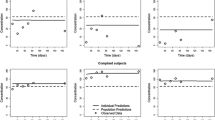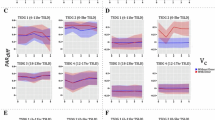Data from clinical trials present numerous problems for the data analyst. These include non-compliance with the prescribed dosing regimen and inaccurate recollection of dosing history by patients as well as mistakes in recording data. Several methods have been proposed to address these issues. One such technique by Lu et al. (Selecting reliable pharmacokinetic data for explanatory analyses of clinical trials in the presence of possible noncompliance. J. Pharmacokinet. Pharmacodyn. 28:343–362 (2001)) identifies occasions in pharmacokinetic (PK) data where the preceding dosing history is likely to be unreliable. We used this method, implemented in the software program NONMEM (beta) VI, to clean a dataset containing indinavir (IDV) plasma concentrations from HIV-1 infected patients. The data was also cleaned by inspection in Microsoft Excel using clinical PK criteria. A one-compartment model with first order absorption and elimination was fit to both sets of cleaned data. IDV population PK parameters obtained from these analyses were similar to those reported previously. It is established that IDV nephrotoxicity is related to high IDV exposure. However, no relationships were found between any PK parameters and nephrotoxicity in the “compliance cleaned” dataset. In the “PK cleaned” dataset, the oral clearance and apparent volume were lower by 9.1% and 6.6%, respectively in patients with any type of nephrotoxicity and the maximum IDV concentration (Cmax) was 12.1% higher. In patients suffering from nephrolithiasis in particular, Cmax was 15.5% higher. Accordingly, the use of the non-compliance detection method did not improve the reliability of our dataset over the usual method of applying clinical criteria. In fact, analyses on the compliance-cleaned dataset missed some exposure-toxicity relationships. Thus, automated methods must be tested rigorously with ‘real life’ datasets, used with caution, and always in conjunction with clinical reasoning to avoid overlooking a signal in noisy data.
Similar content being viewed by others
References
Lu J., Gries J.M., Verotta D., Sheiner L.B. (2001) Selecting reliable pharmacokinetic data for explanatory analyses of clinical trials in the presence of possible noncompliance. J. Pharmacokinet. Pharmacodyn. 28:343–362
Sheiner L.B., Steimer J.L. (2000). Pharmacokinetic/pharmacodynamic modeling in drug development. Annu. Rev. Pharmacol. Toxicol. 40:67–95
Peck C.C., Barr W.H., Benet L.Z., Collins J., Desjardins R.E., Furst D.E., Harter J.G., Levy G., Ludden T., Rodman J.H. (1994). Opportunities for integration of pharmacokinetics, pharmacodynamics, and toxicokinetics in rational drug J. Clin. Pharmacol. 34:111–119
Guidance for Industry on Population Pharmacokinetics (1999). Available at: http://www.fda.gov/cder/guidance/1852fnl.pdf
Aarons L., Balant L.P., Mentre F., Morselli P.L., Rowland M., Steimer J.L., Vozeh S. (1996). Practical experience and issues in designing and performing population pharmacokinetic/pharmacodynamic studies. Eur. J. Clin. Pharmacol. 49:251–254
Vrijens B., Goetghebeur E. (1999). The impact of compliance in pharmacokinetic studies. Stat. Methods Med. Res. 8:247–262
Urquhart J. (1994). Role of patient compliance in clinical pharmacokinetics. A review of recent research. Clin. Pharmacokinet. 27:202–215
Morris L.S., Schulz R.M. (1992). Patient compliance – an overview. J. Clin. Pharm. Ther. 17:283–295
Girard P., Blaschke T.F., Kastrissios H., Sheiner L.B. (1998). A Markov mixed effect regression model for drug compliance. Stat. Med. 17:2313–2333
Kenna L.A., Sheiner L.B. (2004). Estimating treatment effect in the presence of non-compliance measured with error: precision and robustness of data analysis methods. Stat. Med. 23:3561–3580
Soy D., Beal S.L., Sheiner L.B. (2004). Population one-compartment pharmacokinetic analysis with missing dosage data. Clin. Pharmacol. Ther. 76:441–451
Mu S., Ludden T.M. (2003). Estimation of population pharmacokinetic parameters in the presence of non-compliance. J. Pharmacokinet. Pharmacodyn. 30:53–81
Ten Have T.R., Joffe M., Cary M. (2003). Causal logistic models for non-compliance under randomized treatment with univariate binary response. Stat. Med. 22:1255–1283
Sato T. (2001). A method for the analysis of repeated binary outcomes in randomized clinical trials with non-compliance. Stat. Med. 20:2761–2774
Korhonen P.A., Laird N.M., Palmgren J. (1999). Correcting for non-compliance in randomized trials: an application to the ATBC Study. Stat. Med. 18:2879–2897
Jonsson E.N., Wade J.R., Almqvist G., Karlsson M.O. (1997). Discrimination between rival dosing histories. Pharm. Res. 14:984–991
Gulick R.M., Meibohm A., Havlir D., Eron J.J., Mosley A., Chodakewitz J.A., Isaacs R., Gonzalez C., McMahon D., Richman D.D., Robertson M., Mellors J.W. (2003). Six-year follow-up of HIV-1-infected adults in a clinical trial of antiretroviral therapy with indinavir, zidovudine, and lamivudine. Aids 17:2345–2349
Olyaei A.J., deMattos A.M., Bennett W.M. (2000). Renal toxicity of protease inhibitors. Curr. Opin. Nephrol. Hypertens. 9:473–476
Gentle D.L., Stoller M.L., Jarrett T.W., Ward J.F., Geib K.S., Wood A.F. (1997). Protease inhibitor-induced urolithiasis. Urology 50:508–511
Bruce R.G., Munch L.C., Hoven A.D., Jerauld R.S., Greenburg R., Porter W.H., Rutter P.W. (1997). Urolithiasis associated with the protease inhibitor indinavir. Urology 50:513–518
Dieleman J.P., Gyssens I.C., van der Ende M.E., de Marie S., Burger D.M. (1999). Urological complaints in relation to indinavir plasma concentrations in HIV-infected patients. Aids 13:473–478
Dieleman J.P., Sturkenboom M.C., Jambroes M., Gyssens I.C., Weverling G.J., ten Veen J.H., Schrey G., Reiss P., Stricker B.H. (2002). Risk factors for urological symptoms in a cohort of users of the HIV protease inhibitor indinavir sulfate: the ATHENA cohort. Arch. Intern. Med. 162:1493–1501
Dieleman J.P., van Rossum A.M., Stricker B.C., Sturkenboom M.C., de Groot R., Telgt D., Blok W.L., Burger D.M., Blijenberg B.G., Zietse R., Gyssens I.C. (2003). Persistent leukocyturia and loss of renal function in a prospectively monitored cohort of HIV-infected patients treated with indinavir. J. Acquir. Immune. Defic. Syndr. 32:135–1427D
Martinez E., Leguizamon M., Mallolas J., Miro J.M., Gatell J.M. (1999). Influence of environmental temperature on incidence of indinavir-related nephrolithiasis. Clin. Infect. Dis. 29:422–425
Saltel E., Angel J.B., Futter N.G., Walsh W.G., O’Rourke K., Mahoney J.E. (2000). Increased prevalence and analysis of risk factors for indinavir nephrolithiasis. J. Urol. 164:1895–1897
Solas C., Basso S., Poizot-Martin I., Ravaux I., Gallais H., Gastaut J.A., Durand A., Lacarelle B. (2002). High indinavir Cmin is associated with higher toxicity in patients on indinavir-ritonavir 800/100 mg twice-daily regimen. J. Acquir. Immune. Defic. Syndr. 29:374–377
Sutherland S.E., Reigle M.D., Seftel A.D., Resnick M.I. (1997). Protease inhibitors and urolithiasis. J. Urol. 158:31–33
Trainor L.D., Steinberg J.P., Austin G.W., Solomon H.M. (1998). Indinavir identification of patients at increased risk of developing nephrotoxicity. Arch. Pathol. Lab. Med. 122:256–259
Gagnon R.F., Tecimer S.N., Watters A.K., Tsoukas C.M. (2000). Prospective study of urinalysis abnormalities in HIV-positive individuals treated with indinavir. Am. J. Kidney Dis. 36:507–515
Kopp J.B., Falloon J., Filie A., Abati A., King C., Hortin G.L., Mican J.M., Vaughan E., Miller K.D. (2002). Indinavir-associated interstitial nephritis and urothelial inflammation: clinical and cytologic findings. Clin. Infect. Dis. 34:1122–1128
Kopp J.B., Miller K.D., Mican J.A., Feuerstein I.M., Vaughan E., Baker C., Pannell L.K., Falloon J. (1997). Crystalluria and urinary tract abnormalities associated with indinavir. Ann. Intern. Med. 127:119–125
Wade J.R., Kelman A.W., Howie C.A., Whiting B. (1993). Effect of misspecification of the absorption process on subsequent parameter estimation in population analysis. J. Pharmacokinet. Biopharm. 21:209–222
Gisleskog P.O., Karlsson M.O., Beal S.L. (2002). Use of prior information to stabilize a population data analysis. J. Pharmacokinet. Pharmacodyn. 29:473–505
Beal S.L., Sheiner L.B.(eds) (1992). NONMEM Users Guide, NONMEM Project Group. University of California at San Francisco, San Francisco
Gulick R.M., Smeaton L.M., D’Aquila R.T., Eron J.J., Currier J.S., Gerber J.G., Acosta E., Sommadossi J.P., Tung R., Snyder S., Kuritzkes D.R., Murphy R.L. (2001). Indinavir, nevirapine, stavudine, and lamivudine for human virus-infected, amprenavir-experienced subjects: AIDS Clinical Trials Group protocol 373. J. Infect. Dis. 183:715–721
DiCenzo R., Forrest A., Fischl M.A., Collier A., Feinberg J., Ribaudo H., DiFrancecso R., Morse G.D. (2004). Pharmacokinetics of indinavir and nelfinavir in treatment-naive, human immunodeficiency virus-infected subjects. Antimicrob. Agents 48:918–923
Fischl M.A., Ribaudo H.J., Collier A.C., Erice A., Giuliano M., Dehlinger M., Eron J.J., Jr., Saag M.S., Hammer S.M., Vella S., Morse G.D., Feinberg J.E., Denter L.M., Eshleman S.H. (2003). A randomized trial of 2 different 4-drug antiretroviral regimens versus a 3-drug regimen, in advanced human immunodeficiency virus disease. J. Infect. Dis. 188:625–634
Pfister M., Labbe L., Lu J.F., Hammer S.M., Mellors J., Bennett K.K., Rosenkranz S. (2002). Sheiner L.B. Effect of coadministration of nelfinavir, indinavir, and saquinavir on the pharmacokinetics of amprenavir. Clin. Pharmacol. Ther. 72:133–141
Pfister M., Labbe L., Hammer S.M., Mellors J., Bennett K.K., Rosenkranz S., Sheiner L.B. (2003). Population pharmacokinetics and pharmacodynamics of efavirenz, nelfinavir, and indinavir: Adult AIDS Clinical Trial Group Study 398. Antimicrob. Agents Chemother. 47:130–137
Acosta E.P., Wu H., Hammer S.M., Yu S., Kuritzkes D.R., Walawander A. , Eron J.J., Fichtenbaum C.J., Pettinelli C., Neath D., Ferguson E., Saah A.J., Gerber J.G. (2004). Comparison of two indinavir/ritonavir regimens in the treatment of HIV-infected individuals. J. Acquir. Immune Defic. Syndr. 37:1358–1366
Zhou X.J., Havlir D.V., Richman D.D., Acosta E.P., Hirsch M., Collier A.C., Tebas P., Sommadossi J.P. (2000). Plasma population pharmacokinetics and penetration into cerebrospinal fluid of indinavir in combination with zidovudine and lamivudine in HIV-1-infected patients. Aids 14:2869–2876
van Heeswijk R.P., Veldkamp A.I., Hoetelmans R.M., Mulder J.W., Schreij G., Hsu A., Lange J.M., Beijnen J.H., Meenhorst P.L. (1999).The steady-state plasma pharmacokinetics of indinavir alone and in combination with a low dose of ritonavir in twice daily dosing regimens in HIV-1-infected individuals. Aids 13:F95–99
Burger D.M., Hugen P.W., Aarnoutse R.E., Dieleman J.P., Prins J.M., van der Poll T., ten Veen J.H., Mulder J.W., Meenhorst P.L., Blok W.L., van der Meer J.T., Reiss P., Lange J.M. (2001). A retrospective, cohort-based survey of patients using twice-daily indinavir + ritonavir combinations: pharmacokinetics, safety, and efficacy. J. Acquir. Immune Defic. Syndr. 26:218–224
Kakuda T.N., Page L.M., Anderson P.L., Henry K., Schacker T.W., Rhame F.S., Acosta E.P., Brundage R.C., Fletcher C.V. (2001). Pharmacological basis for concentration-controlled therapy with zidovudine, lamivudine, and indinavir. Antimicrob. Agents Chemother. 45:236–242
Acosta E.P., Henry K., Baken L., Page L.M., Fletcher C.V. (1999). Indinavir concentrations and antiviral effect. Pharmacotherapy 19:708–712
Csajka C., Marzolini C., Fattinger K., Decosterd L.A., Telenti A., Biollaz J., Buclin T. (2004). Population pharmacokinetics of indinavir in patients infected with human immunodeficiency virus. Antimicrob. Agents Chemother. 48:3226–3232
Aarnoutse R.E., Wasmuth J.C., Fatkenheuer G., Schneider K., Schmitz K., de Boo T.M., Reiss P., Hekster Y.A., Burger D.M., Rockstroh J.K. (2003). Administration of indinavir and low-dose ritonavir (800/100 mg twice daily) with food reduces nephrotoxic peak plasma levels of indinavir. Antivir. Ther. 8:309–314
Sisson S. (2005). Trans-dimensional Markov chains: a decade of progress and future perspectives. J. Am. Statis. Assoc. 100:1077–1089
Author information
Authors and Affiliations
Corresponding author
Additional information
Lewis B. Sheiner: Deceased
Rights and permissions
About this article
Cite this article
Kshirsagar, S.A., Blaschke, T.F., Sheiner, L.B. et al. Improving Data Reliability Using a Non-Compliance Detection Method versus Using Pharmacokinetic Criteria. J Pharmacokinet Pharmacodyn 34, 35–55 (2007). https://doi.org/10.1007/s10928-006-9032-2
Received:
Accepted:
Published:
Issue Date:
DOI: https://doi.org/10.1007/s10928-006-9032-2




